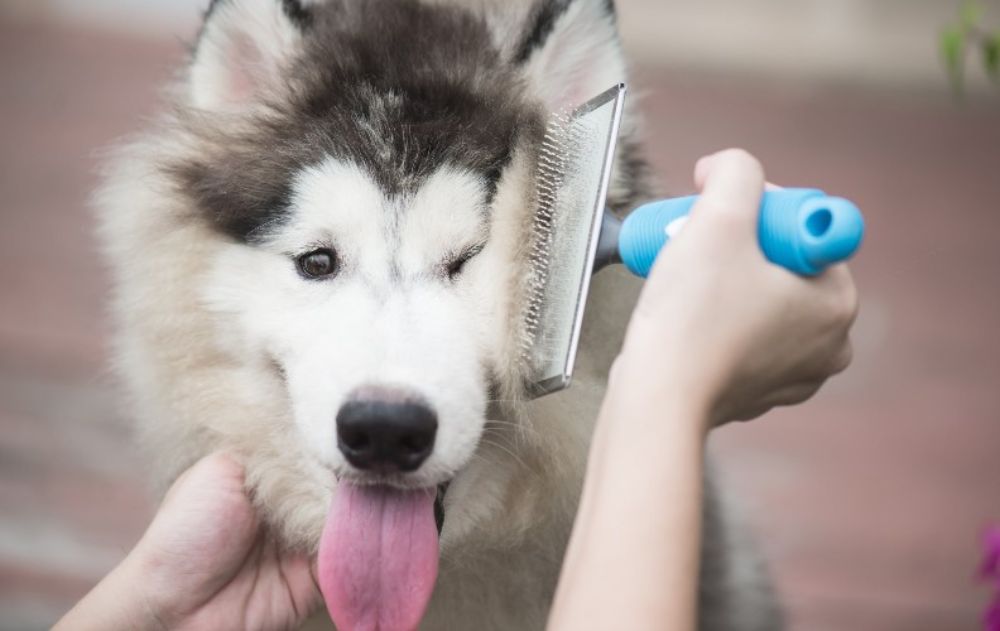Fleas are pesky little parasites who can’t get enough of your dog. The bad news: your dog is likely to get them at some point, and on top of all that scratching, fleas can cause serious health problems if left to get on with it. The better news: there are plenty of things you can do to treat your pet's fleas.
Watch the video below to see Everypaw’s vet, Anna, demonstrating how to check a dog’s fur and skin for fleas.
Fleas: What are we Dealing with?
As a parasite, every flea needs a host - basically a mobile hotel with a free, well-stocked mini-bar. Domestic pets are well-fed, healthy and live somewhere nice and warm. As hosts go, our furry friends (along with their baskets and blankets) offer the flea equivalent of 5-star accommodation.
Over time, subspecies of fleas have evolved to prey on different types of animal (hence you get dog fleas, cat fleas and human fleas). That said, many fleas can and will infest more than one species. In fact, the cat flea is one of the most commonly encountered flea species among the dog population.
Flea Facts: How they Can Affect You and Your Dog
- You can see them pretty easily with the naked eye. They’re brown and around 2.5mm long. Easy to spot on the fur of a Westie; less so with a Chocolate Lab.
- They really are expert jumpers. Some types of flea can jump more than a hundred times their own body length.
- Only adult fleas live on your pet. The early stages live free in the environment.
- Individual fleas can survive for a long time. Some fleas can live up to a year. Adult dog fleas can live up to 100 days. And a female can lay up to 50 eggs a day - so it’s easy to see how an infestation can soon take hold.
- Flea eggs can take up to two years to hatch. If an adult flea lays its eggs in your dog’s coat, they’ll usually hatch within two weeks. However, if the conditions aren’t quite right, they can survive in a dormant state for a long time (up to two years!). The eggs are pearly white, about the size of a grain of salt.
- Many eggs are laid in carpets and rugs where they hatch into maggot-like larvae. The larvae develop into hungry adult fleas looking for a warm-blooded animal to hop onto.
- Most adult fleas have a 2-3 month life cycle.
- Only female fleas feed on the dog’s blood.
- Fleas only spend 5% of their lifecycle on your dog. The rest of their time will be spent waiting for another host.
How to Spot a Dog Flea Problem

If your dog is scratching, licking or chewing certain areas of the body more than normal, it’s a sign that something’s irritating their skin. It could be fleas - but it might be down to another cause such as dry skin or an allergic reaction.
Check their fur for actual fleas. Turn your dog onto their back to check the groin and armpits (fleas prefer these spots as they are warm and protected).
Next, comb through your buddy’s hair with a flea comb (this is a metal comb with close-set teeth). It’s best to do this over a white surface or a piece of paper so you can inspect any droppings that fall out. If there are black specks on the paper, and if these turn red-brown when you pour a little bit of water on them, this pretty much confirms that fleas are present.
Why Fleas are Bad for Your Dog
Individual dogs react in different ways to fleas. Most become increasingly more itchy as the infestation takes hold. If they’re constantly rubbing, scratching or licking the same area, there will typically be hair loss, the skin will break and infection can set in around the scratch sites.
Some dogs develop an allergy to flea saliva, known as flea bite dermatitis or flea allergy dermatitis (FAD). Even with just one or two bites, this can lead to severe itching and inflammation. Episodes of flea bite dermatitis tend to get worse as your dog gets older and appear more in the summer when the flea populations are at their highest.
Fleas bite their hosts to feast on their blood. Bite-by-bite, we’re talking tiny amounts, but it can become a bigger problem as the infestation grows. Loss of blood over time can lead to anaemia, especially in very young or old dogs - and in smaller dogs that have less blood to spare.
If all this isn’t enough, fleas can also carry tapeworms. If your dog swallows fleas (by licking their fur during grooming, for instance), they can end up eating tapeworms, too. These worms make their home in the intestine, where they interfere with the absorption of nutrients. If you notice fleas on your pet, treat them for tapeworm too.
Are Dog Fleas Bad for Humans?
While the fleas that infest dogs have a definite preference for canine blood, they will often bite humans, too.
Typically, a bite leads to a very small area of redness and itchiness that soon passes (like a mosquito bite).
But just like dogs, humans can get flea bite dermatitis, where even a single bite can cause a lot of irritation and swelling.
Fleas are most likely to jump from dog or carpet to human where the infestation has grown very large, or if your dog likes to come into your bed and the fleas have got into the sheets or duvet.
How to Treat Dog Fleas
If fleas are present, consult your vet. There are lots of flea products and treatments for dogs out there, and your vet will recommend the best one for you, based on the age, breed and size of your dog.
There are three ways to control fleas: kill the adult fleas, make the adult female fleas sterile or prevent the immature stages from developing. The last two methods are good at preventing reinfestation but don’t get rid of the adult fleas already there, so you may also have to use another product to do this.
Preventative flea control can be applied topically (on the skin) or systemically (by mouth or injection). Some products last for up to 1 month, others for up to 12 weeks, others for longer. The key to success is to follow the manufacturer’s recommendations.

Topical treatment takes the form of a “spot-on” capsule applied to the skin at intervals or an oral preparation. The back of the neck is a good place as the dog can’t then lick it off. There are also sprays, flea shampoos and powders that will kill the fleas at the time of treatment, but these often have to be regularly re-applied.
Flea collars can be an effective treatment, where the chemicals from the collar diffuse over the pet’s coat to kill the adult fleas. Ask your vet to recommend the best product for your pet as those sold in the supermarket or pet stores may not always be very effective.
Dogs can also be treated with tablets (some are chewable) or by injection.
Severe infestations (they might occur after closing the house up for a holiday) require treatment of your dog’s bedding, carpets and rugs. Meanwhile, get cleaning and get rid of that flea dirt! Wash all bedding and vacuum the furniture, floors and skirting boards, remembering to dispose of the vacuum bags to prevent further infestation.
Your vet will be happy to give you advice on which product or combination of products to use. At the same time, especially if your dog has flea bite dermatitis, they may prescribe some anti-inflammatory or antihistamine medication to reduce swelling.
Fleas can breed all year round in our centrally-heated homes so your dog needs to be treated regularly, all year round. Prevention is essential - even if you don’t see fleas, it’s a good idea to continue to treat your dog and home all year round. Most flea control products are very safe if you follow the instructions on the packaging.
And don’t forget that you will need to treat all dogs and cats in the household (but NEVER treat a cat with a dog flea treatment as it may be toxic to them).
Everypaw Dog Insurance
Everypaw's Dog Insurance comes with 24/7 unlimited access to vets and vet nurses that can help with your pet's health, care, nutrition and behaviour. So you can rest assured your pup will be well looked after.
Content reviewed by Vetstream Canis - https://www.vetlexicon.com/treat/canis
Vetstream’s Vetlexicon is the world’s largest peer-reviewed online clinical reference source. All our content is written and peer-reviewed by over 1,000 of the world’s leading veterinarians, ensuring relevance, accuracy and quality.
- Vetstream Ltd (online) Fleas – an itchy business. In: Vetlexicon Canis. Vetstream Ltd, UK. Website: https://www.vetlexicon.com/treat/canis/client-information/fleas-an-itchy-business
- Vetstream Ltd, Elizabth Youens (online) Flea control. In: Vetlexicon Canis. Vetstream Ltd, UK. Website: https://www.vetlexicon.com/treat/canis/client-information/flea-control
- Omowumi Ajao, Maggie Fisher, Linda Horspool, Rosanna Marsella (online) Flea control. In: Vetlexicon Canis. Vetstream Ltd, UK. Website: https://www.vetlexicon.com/treat/canis/freeform/flea-control
- Rosanna Marsella, Richard Squires (online) Skin: flea bite hypersensitivity. In: Vetlexicon Canis. Vetstream Ltd, UK. Website: https://www.vetlexicon.com/treat/canis/diseases/skin-flea-bite-hypersensitivity